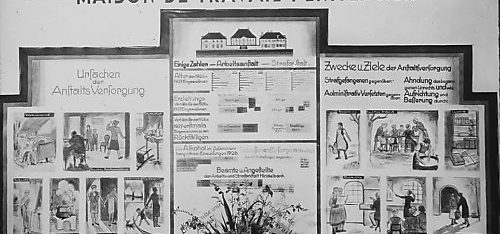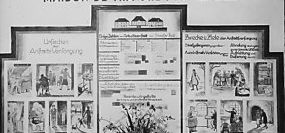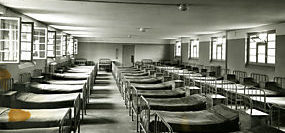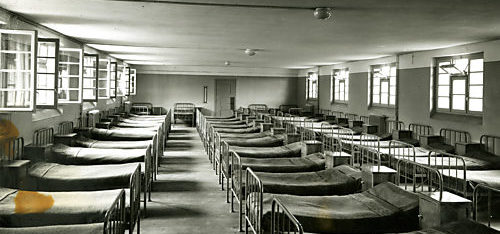Sources
The sources consulted include documents and other records that can provide insight into the past. In addition to the written sources used in their INVESTIGATIONS, researchers also study audio recordings and pictures, visit the buildings where detainees were held, and conduct interviews with contemporary eyewitnesses.
Sources on the history of administrative detention
The majority of the written documentation has been preserved by public institutions: cantonal or communal archives, a number of special archives, the Swiss Federal Archives and libraries. Private archives maintained by institutions, associations or private individuals were also consulted where possible. In addition, the IEC conducted personal interviews with individuals who were subject to such measures or who were employed by the public authorities or institutions involved. Those interviews are also treated as sources.
The sources available do not present a neutral, unfiltered picture of a past reality. As a rule they represent only one perspective on the events. Moreover, not all documents or other records have survived, even where the events in question were relatively recent. The work of the Commission’s research team is now to identify from among the available material those sources that are of relevance to their research. In doing this they maintain a constant dialog between the selected evidence from the past and the continuously evolving state of present knowledge.
We present here a regularly updated sampling of sources used by the IEC researchers in their work.


|

|
||
| 1928 | 1948 | ||
| The Hindelbank Correctional Labour Facility: A Place of Reformation and Redemption? | A (mass) dormitory in Bellechasse | ||
| From 1866 onwards, the State of Bern used the former Baroque summer residence of the Bernese patrician family von Erlach as a poorhouse for women. From 1896 onwards, it served as a workhouse, and since 1912 it has also housed the female inmates of the cantonal prison. | The archival records on the Bellechasse correctional facilities contain numerous photographs taken over several decades. In the course of renovations that were carried out on the «re-education house» in 1948, a local professional photographer took a series of pictures. Among them was this photograph of the new dormitory. | ||
| Learn more | Learn more |

ANALYSIS OF SOURCES
Selecting the relevant sources is the first step in the actual process of historical analysis. Different perspectives, different approaches and a never-ending succession of questions: The ability to deal with historical sources is one of the fundamental skills needed by researchers. It is their job to put the sources in context, to analyse them, and on that basis to formulate working hypotheses. In this way it becomes possible to get a better understanding of the interrelationships between events.
In the following, the most important steps in the process of source analysis will be briefly explained:



Description of sources
Before any source can be properly described, certain formal information must first be gathered. This makes it possible to categorize the sources preserved in the archives and to catalogue them in accordance with specific criteria (see examples below). The work of the Commission’s researchers rests on this preliminary processing of the sources, which is done in most cases by the archivists themselves. Researchers have a responsibility to mention this fact in their publications and to provide a systematic presentation of the references. This is to ensure that each source mentioned in the analysis can be easily located and consulted.


- SIGNATURE: The signature is an identification code: it indicates the name of the archive and of the specific collection in which the source is preserved. Each signature is unique so that there can be no confusion between the sources.
- TITLE: The designation assigned to the source, which also includes information about the content and the purpose for which it was established.
- DATE OF ORIGIN: This provides an indication of the time period to which the origin of the source can be traced.
- ORIGIN/PROVENANCE: Individual documents are normally found within larger sets of records, which are organised into collections. Here, information about the circumstances under which the sources originated plays an important role. The relevant information includes, among other things, the name of the organisation or person who created, processed or collected the records in question.
- FORM AND CONTENT: In addition to the title, this rubric provides further information on the content, the structure and the form of the source (printed or digital record, etc.).
- RULES OF ACCESS AND USE: Depending on the date of origin and the content, some sources may be classified and protected by a non-disclosure term.
- PHYSICAL CONDITION: Because of the condition in which they have survived, certain sources may not be available for consultation in the original.


GATHERING PERSPECTIVES
Once a sufficient number of sources has been collected, it is possible to begin the process of analysing them. Different perspectives on the sources are correlated with one another and existing studies on the subject are consulted. The end result is a scientifically based research report.



Publication of results
Books, newspaper articles, films, websites and other media are used to make the research results known to a broader public. In this way is possible for a widely shared understanding of the past to take shape. That understanding remains in constant flux and continues to evolve as new research becomes available. By making their results available to the public, researchers are thus able to contribute to the development of a nuanced and open-minded understanding of the past by the society in general.



